
Lakki and Agia Marina
Agia Marina and Lakki
I went to Lakki and walked through its strange
Rationalist architecture.
The town was built by Italy in the 1930s
and named Porto Lago.
Then I returned to Agia Marina to see more of it.
First, though, breakfast along the waterfront in Agia Marina.
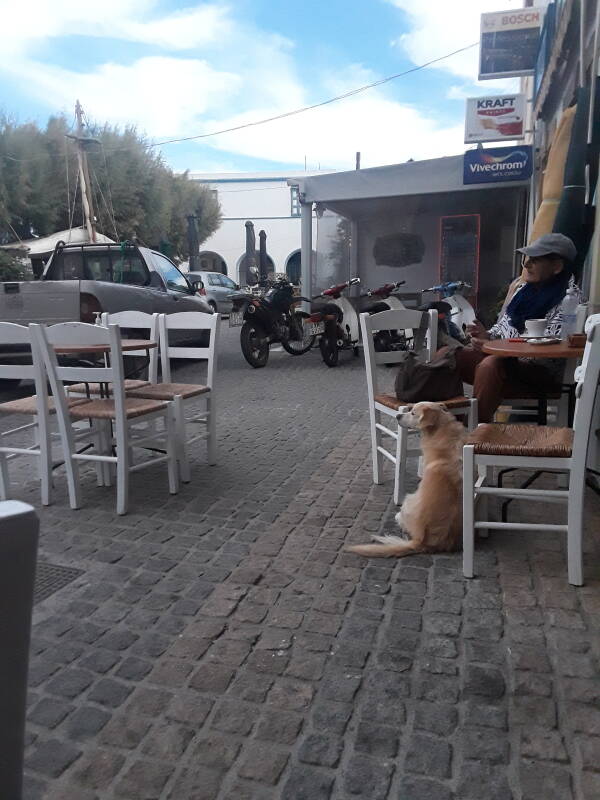
Razionalismo, the Italian Fascist Architecture of Lakki
Italy took control of the Dodecanese island chain in 1912. And then Mussolini's National Fascist Party took control of Italy in 1922 with a coup d'état.
The island of Leros had a fantastic natural harbor, a deep-water bay on its southwest side that was 3.5 kilometers long and one kilometer wide. It was an obvious place to establish a naval base. It was mostly uninhabited due to the innermost section of its shoreline being a mosquito-plagued swamp.

"Drain the swamp!", the Fascist leader commanded.
Italy began with a seaplane base in the 1920s. In the early 1930s Mussolini commanded the design of a planned community that would embody the "modernist, rationalist, and utopian ideas" of his Fascist party. The new town was named Porto Lago.
The Rationalism architectural movement or Razionalismo had developed in early 20th century Italy. It emphasized simple, functional design which it explained as "ideals of purity, reason, and universalism".
What came to be called Modernism and the Futurist movement were developing at the same time. Those design movements along with Art Déco and Bauhaus strongly influenced Rationalism.
The others became widespread and have at least partly survived. However, the only remaining Rationalist towns are Lakki, Sabauda near Rome, and Asmara in today's Eritrea, another former Italian colony.
Amazon
ASIN: B005C7FWZE
It's a distinctive look, what people in the past thought the future would look like. It seemed to me as if I was stepping into a Constructivist Soviet film set that was unexpectedly in full color. Guy Maddin would dig the esthetics.
Mussolini directed Armando Bernabiti and Rodolfo Petracco, two Modernist architects, to follow the Rationalist motif while designing a community for the Italian military and support personel associated with the new large base. Many ship loads of concrete were brought from Italy.
Bernabiti and Petracco were eccentrics who merged strict Rationalism with everything from Byzantine to Art Déco design. It worked out for them — after Porto Lago they were commissioned for designs on Kos and Rhodes, other parts of Italy's failed Dodecanese empire.
Pre-revolutionary Russians had a saying about "God is in heaven and the Tsar is in Moscow", with the unspoken implication that in the hinterlands of Mother Russia you would get away with most anything. I suppose the same thing goes with Il Duce in Rome and architecture in the Aegean.
The movie theater with its rounded front was completed in 1938.

Amazon
ASIN: B00474ID4U
The movie theater would be a fantastic place for a Guy Maddin film festival.
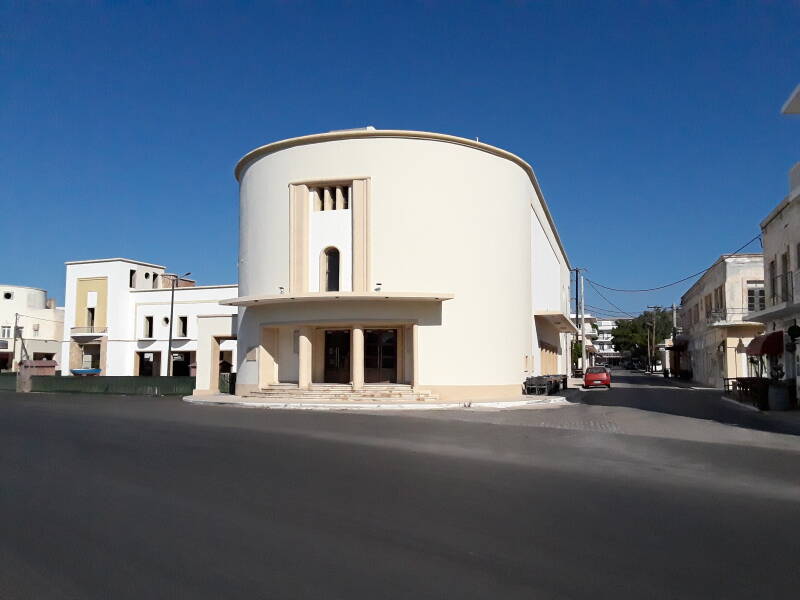
The streets are broad, radiating outward from the waterfront and intersecting with cross streets curving around parallel to it.
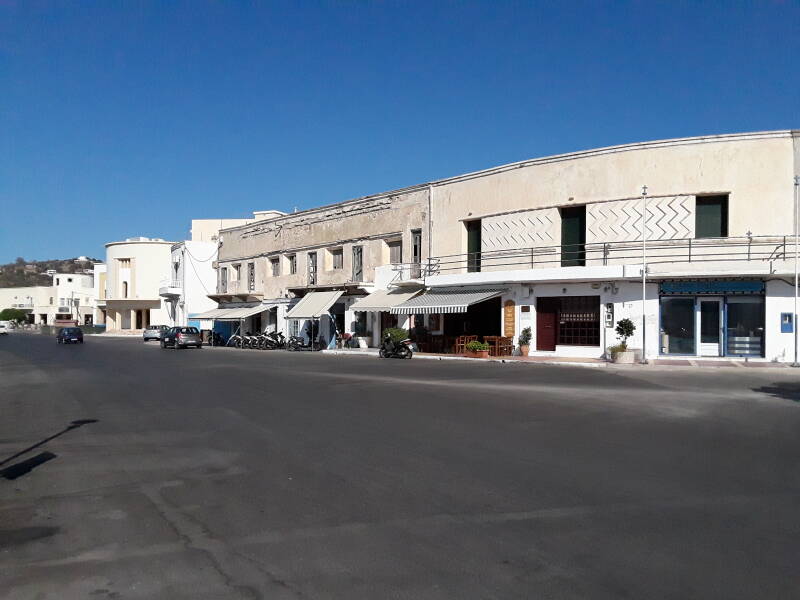

By the late 1930s, over 8,000 people lived here. That made Leros the only Italian-controlled island where Italians outnumbered the native people. Now the population of the entire island is a little under 8,000. Or at least the voluntary population, more on that later.
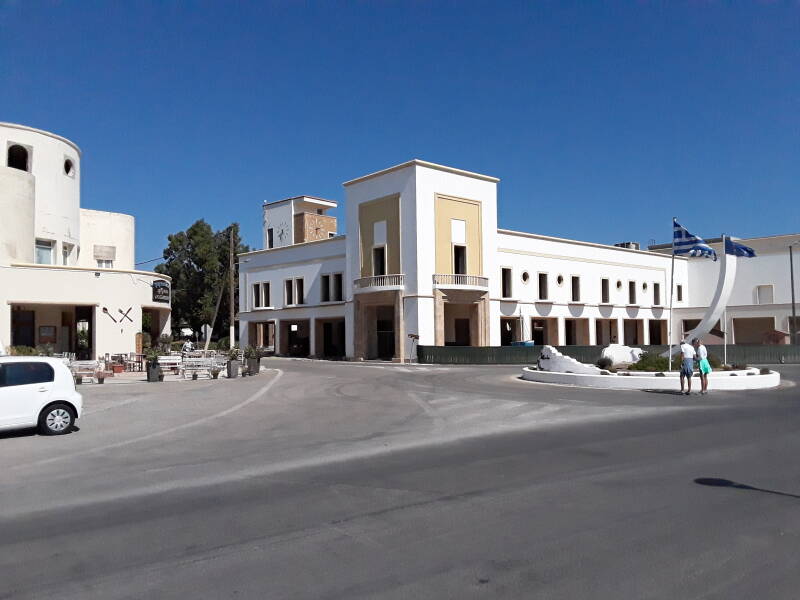
The elementary school is still used for its original purpose.

The clock tower is next to two circular market buildings.
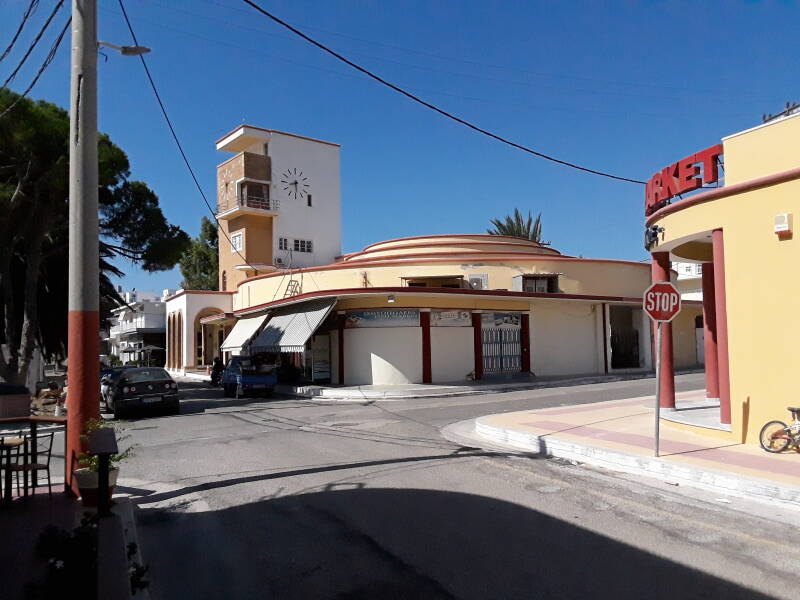
It displays different times on all four faces.
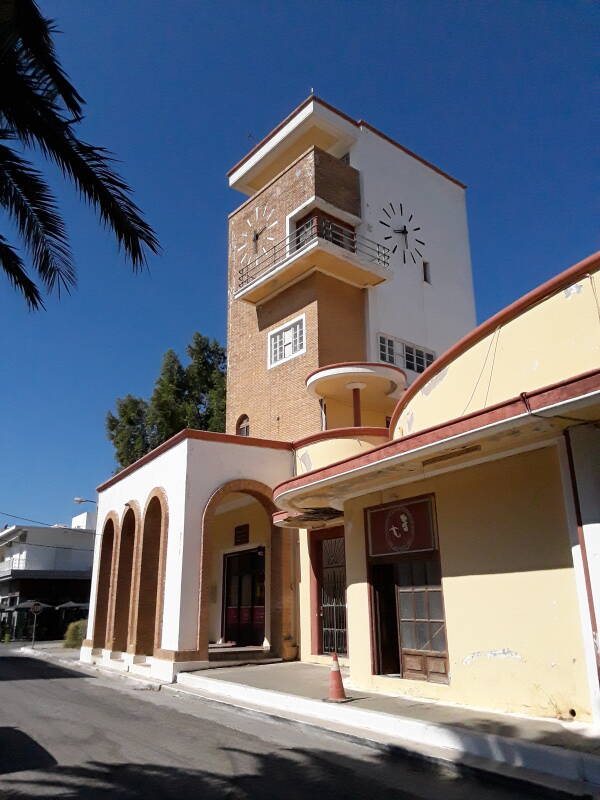
The town was renamed Lakki after the war. The local people mostly forgot the historical significance of the town's architecture after the end of World War II. If they thought anything about it, then it was as a reminder of Italian fascist rule. Buildings were demolished, modified, or simply fell into ruin through lack of maintenance.
Today there are fewer than 2,000 people living in Lakki, and the island's total population is about the same as that of just Lakki during Italian rule. The broad streets and large buildings have made Lakki the quiet home of several Leros businesses.
Petracco and Bernabiti returned to Italy after the war to discover that they architectural philosophy was forgotten at best, and soundly linked with Mussolini's Fascist regime when remembered at all. Both of them them died in obscurity.
That seems to have been the end of Rationalist architecture. If you want to see it, visit Lakki.

The Asylum, the Gulag, and the Hotspot
I want to skip the unpleasant partGreece is a great place to visit. Beautiful scenery, interesting history, friendly and welcoming people. But some of the recent history is unpleasant.
An Italian Fascist naval base was a bad enough historical association. But then late in the war Leros became home to a prison for internal political exile, then a notorious psychiatric hospital that was more of a labor camp, then an even worse internal political exile camp, and then a facility where Middle Eastern, Asian, and African refugees are still confined in harsh conditions.
1943–1949 — Greek Civil War
A civil war started in Greece before World War II had ended and lasted until 1949. It started during the Axis occupation as a conflict between pro-communist and anti-communist resistance groups. By the end it was supporters of the KKE, the Communist Party of Greece, fighting against the Kingdom of Greece. The national government used the former Italian base on Leros as a remote site in which to "re-educate" the children of Communists.
1957–today — psychiatric hospital or exile
In 1957 the former Italian adminirality on the southeast shore of the Lakki harbor was officially repurposed as a psychiatric hospital. The plan was to make it a colony of mental patients and put them to work on agricultural pursuits.
The initial plan was to select existing mental patients who hadn't been visited by family for at least 12 months, and send them to the Leros agricultural colony. The first 300 arrived in January 1958. By that time the facility was named the Leros Colony of Psychopaths and had a capacity of 650 beds.
It quickly became much more of a prison and labor camp than a hospital, growing to 2,000 beds by 1980. At its peak the staff numbered about 1,000, only two of whom were psychiatrists. Almost all of the staff, hired from the local population, served as guards. There was almost no medical care.
Guard work pays the bills, but it can be psychologically difficult. Leros was known as the island with the highest rate of alcoholism in Greece.
See the 2016 paper "Psychiatric reform in Greece: an overview" for a description of the vast improvements in Greek psychiatric care since the 1980s.
The horrible conditions began to be reported in foreign media in the early 1980s, and the government stopped transferring more patients to Leros in 1982. The UK Observer published a highly influential article in 1989 describing the patients' severe deprivation and violation of basic human rights. But it remained one of the largest psychiatric hospitals in Europe until 1995. Since around 2005 the E.U. has been financing programs to get patients out of indefinite institutionalization, but about 200 patients are still there.
Now the Leros hospital's web page reports that the general hospital building in Lakki has 80 beds with a nearby "Department of People With Special Needs" with 54 patients. The Psychosocial Rehabilitation program has two buildings in Lakki with 34 chronic patients. Plus, at the former Italian base in Lepida, structures housing 97 chronic patients and a 15-bed Department of Acute Psychiatric Cases which receives patients sent there by the legal system.
The health care service also rents 11 protected apartments where 46 patients live, four to six per apartment with care by the health service staff.
1967–1974 — exile under the military dictatorship
Meanwhile, in 1967 a right-wing coup established the Colonels' Junta. That military dictatorship harshly restricted civil liberties and subjected the regime's political opponents to imprisonment, torture, and internal exile.
Leros was one of several islands used for internal exile. The old Italian military depots and barracks became political prisons, adjacent to the mental hospital. Around 4,000 political prisoners were locked up on Leros.
Of course, just like Communist dictatorships, right-wing dictatorships will also label their opponents as mentally ill and imprison them in facilities referred to as hospitals.
The Colonels' Junta lasted from 1967 to 1974.
2010–today — migrant crisis
2015 European migrant crisisIn 2010 Europe was receiving increased numbers of refugees due to conflicts in parts of the Middle East, Asia, and Africa. The wars in Syria, Iraq, and Afghanistan were major causes, and terrorist insurgencies in Nigeria and Pakistan plus long-term human rights abuses in Eritrea contributed more.
Millions of people had sought refuge in relatively stable countries near their origins, but those countries didn't have the resources to support millions of refugees. Millions of Syrian refugees were in squalid camps in Jordan and Lebanon. Those who made it to Turkey weren't allowed to work.
It gradually became clear that many of the wars would not end in the foreseeable future. People were looking to settle somewhere permanently. Lebanon, Jordan, and Egypt stopped accepting Syrian asylum seekers in 2014. This caused a large surge in the number of people fleeing to Europe in 2015.
Before 2015 most refugees had reached Europe by crossing the Mediterranean from Libya to Italy. They were mostly from Sub-Saharan Africa, crossing Libya after its border controls had collapsed during the Second Libyan Civil War of 2014–2020.
The vast majority of refugees coming to Europe in 2015 were coming from Syria, but there were also significant numbers from Afghanistan, Iraq, Pakistan, Nigeria, and Eritrea. They entered Turkey by land and then crossed the Aegean to Greece, mostly to the islands close to the Turkish coast. A border fence built on Turkey's European border in 2012 forced them into the water route.
1.3 million people arrived in Europe seeking asylum in 2015. That was the most in a single year since World War II. At times the incoming refugees outnumbered locals on some of the Greek islands. Greece appealed to the European Union for assistance, and the UN High Commissioner for Refugees described the situation on the Greek islands as "totally inadequate" and "in total chaos".
European Council on Refugees and Exiles — Asylum Information DatabaseTheir plan once in Greece was to continue into Europe, which would take them into countries already overwhelmed by the arrival of tens of thousands of refugees.
Greece established "hot spots" on Lesvos, Chios, Samos, Leros, and Kos. The one on Leros was set up in December 2015. It had a refugee camp with an initial capacity of 1,000. That was a fenced complex of housing built from shipping containers set up in the square between the old hospital and the harbor. In 2021, 200 refugees were still living there.
Capacity for 1,780 had been set up elsewhere on Leros, I think on the hill overlooking the former naval base. An area including the psychiatric hospital occupying the former Italian admiralty and from there to the former naval base is pixillated like a military site on Google Maps. You can see it from the opposite side of the harbor, over a kilometer away.
The refugees kept arriving with no where to go. The government planned to expand the hotspots, but the local citizens and authorities protested this.
The Panhellenic Union of Public Hospital Employees filed a complaint in October 2019 stating that 1,500 refugees were living in squalid conditions at the (supposedly former) psychiatic hospital alongside 154 mental patients. According to the Greek Reporter the original plan was for temporary accommodation at the hot spot, but that had "gradually evolved into an open hosting structure" where they said that "750 people can barely fit in the premises and now the place hosts more than 1,500."
By early 2021 the national government was building a new closed detention center to accommodate around 2,000 refugees. The mayor of the island was appealing the plan, saying that the island with a population of around 8,000 didn't have water and electrical service capacity for an additional 2,000 people.
The local people want to get away from Leros' past as a notorious detention center. The government has promised that the expanded refugee detention center will be a "closed and controlled" system that tourists will barely notice. And, that it will provide jobs for the local people as guards. All that satisfies some of the complaints, but it still sounds rather dystopian.
Refugee support organizations and other NGOs have pointed out that from 2020 to 2021 the number of arriving refugees had decreased by 80%. They question the need for expanded detention centers.
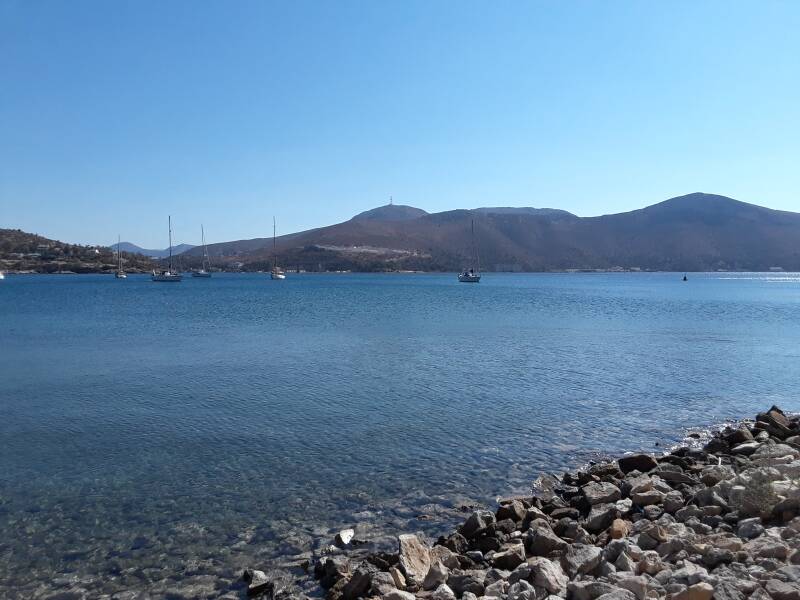
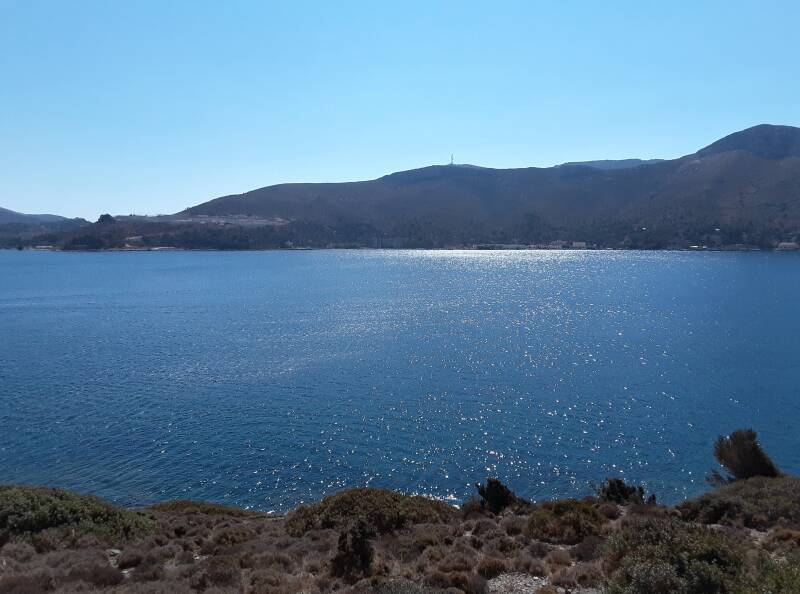
Back in Agia Marina
Platanos is the administrative center of Leros, with the Town Hall, the library, and the historical archive.

Platanos tavernas host intense backgammon games.
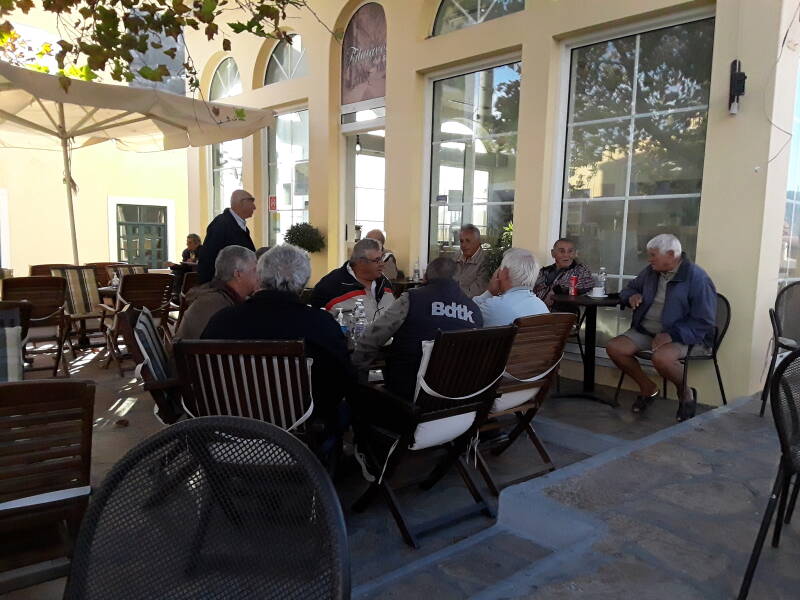
I continued back through Agia Marina toward where I was staying in Alinda.
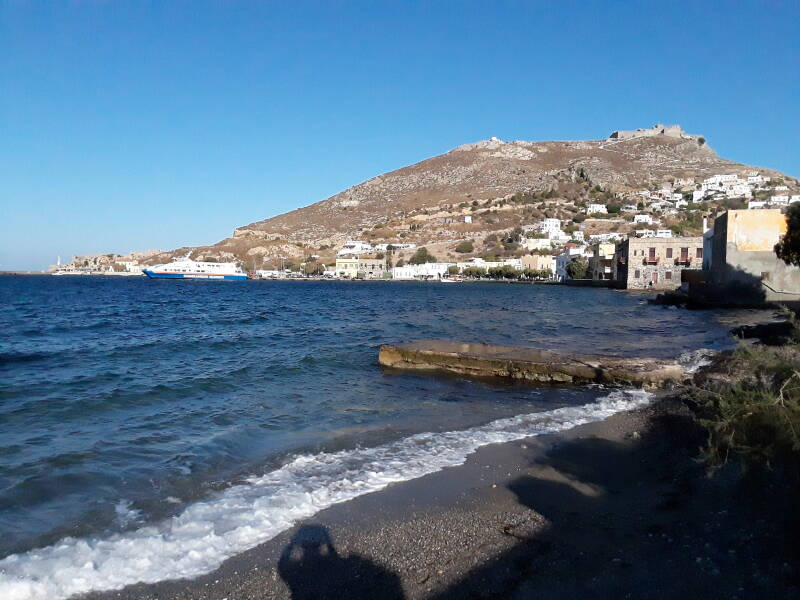
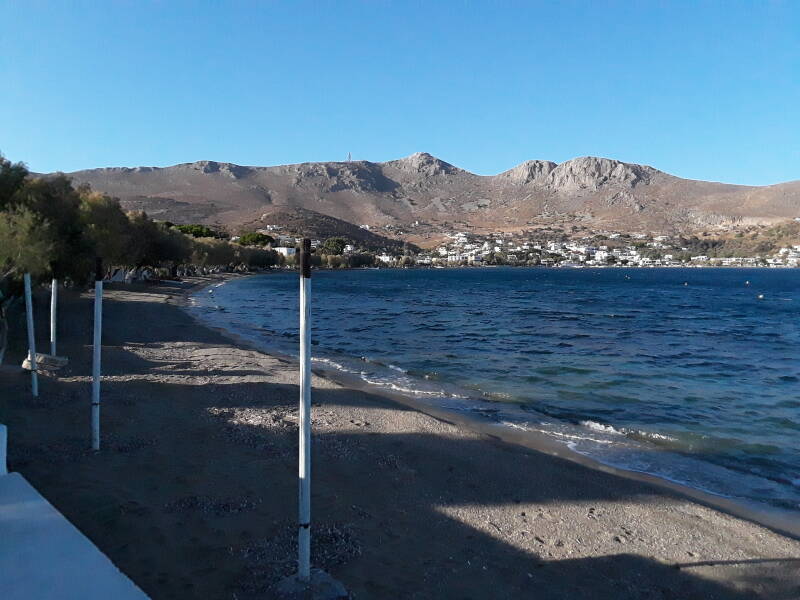

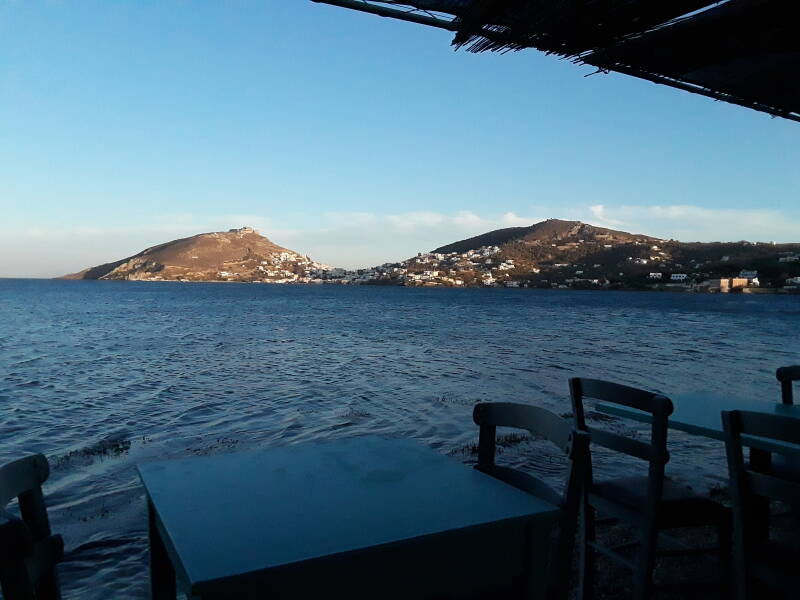
I got dinner that evening in a taverna near where I was staying. Chicken souvlaki and house red wine.
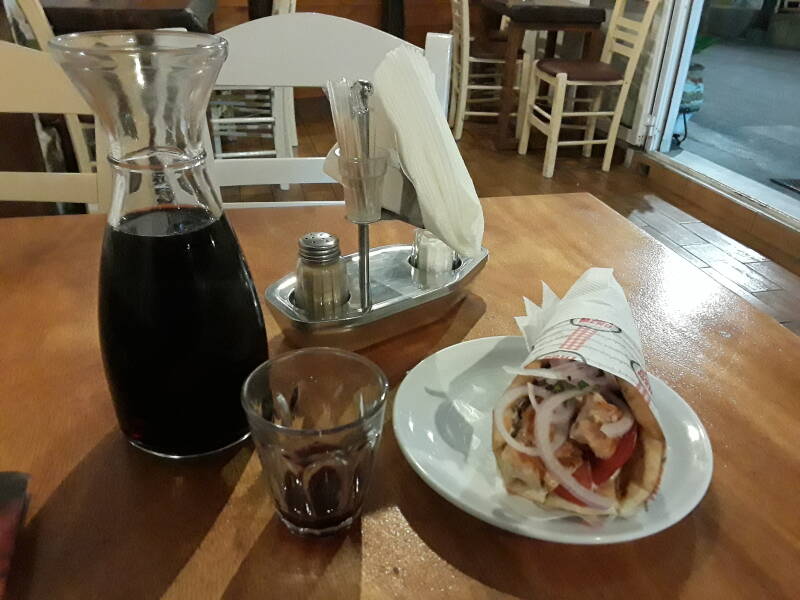
Or, Continue Through Greece: